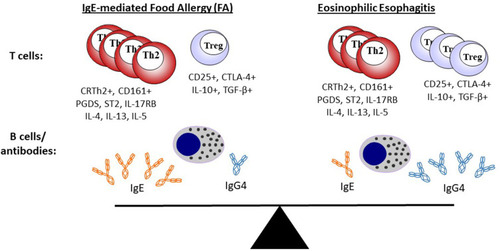Figures & data
Table 1 Evidence That EoE is a Form of Chronic Food Allergy
Table 2 Summary of Characteristics in EoE and IgE-Mediated Food Allergy
Figure 1 EoE is a local inflammatory disease of the esophagus and FA is a systemic allergic disorder, but both represent a continuum of food-related allergic disease. Th2 cells and Tregs are present in different relative amounts, but share similar surface markers and cytokine-expression profiles in both EoE and FA. Food-specific IgE and IgG4 are common in both EoE and FA, but the relative ratio of IgE is higher in FA. Changes that occur with diet or treatment (eg, oral immunotherapy) will influence the adaptive immune response and may change the dynamic equilibrium between EoE and FA.

